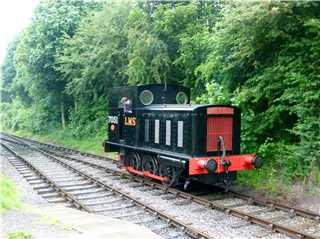The LMS pioneered the use of diesel shunting locomotives in Great Britain.
3 have been preserved:
LMS diesel shunter 7050 is an experimental 0-4-0 diesel-mechanical shunting locomotive, introduced by the LMS in 1934 and which remained in service with that railway for six years and was used for dock shunting at Salford before being loaned to the Air Ministry in 1940. It was withdrawn from LMS stock in March 1943 and sold to the War Department which numbered it 224. Subsequent renumbering by the WD, and later the Army, saw it carry numbers 70224, 846 and 240. At some point it was rebuilt with a Gardner engine and was used at the Royal Navy base at Botley, Hampshire. In 1979 it was preserved by the Museum of Army Transport in Beverley, and later the National Railway Museum.
LMS diesel shunter 7051 was built by the Hunslet Engine Company to demonstrate its wares. After public exhibition in February 1932, it was used for trials at a colliery, before being tested by the LMS and was subsequently purchased by the LMS in May 1933. It was loaned to the War Department from August 1940, which numbered it 27. During 1941–1944 it was returned to the LMS, but in August 1944 it returned to the WD, now numbered 70027. After the end of World War II, it was returned to the LMS but was withdrawn in December 1945 and resold back to Hunslet. Hunslet used the locomotive as a works shunter, but it was also available for hire and spent time at oil refineries in Essex and with British Railways. In September 1960 the locomotive was preserved by the Middleton Railway.
LMS diesel shunter 7069 (British Rail Class D3/6) was based on the English Electric 6K of 300 horsepower (220 kW) diesel engine, with a long bonnet, 0-6-0-wheel arrangement, EE 6K prime mover and two axle-hung traction motors. It was built by Hawthorne Leslie to English Electric design. Ten further locomotives of the same design, with minor alterations and uprated to 350 horsepower, were built in 1935 and taken into LMS stock in 1936. These were numbered 7069-7078 by the LMS. Three of these later became British Railways numbers 12000–12002. They spent their working lives allocated to Crewe South Locomotive Depot. The remainder of the class were sold to the British War Department in 1940 and were shipped to France during World War II. Of these, the first production locomotive, No. 7069, survived the war and was used in industrial service in France. It was later repatriated for preservation by the Berkeley Vale Railway.
